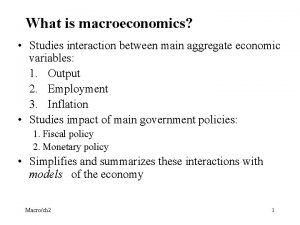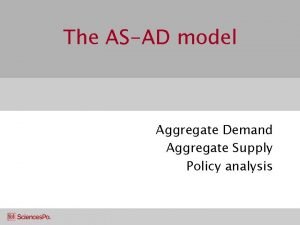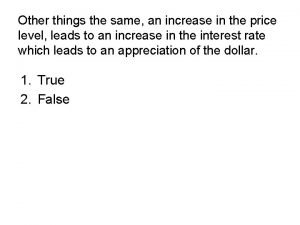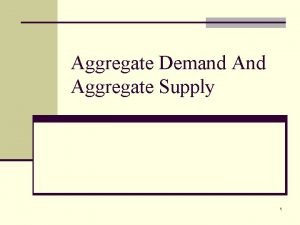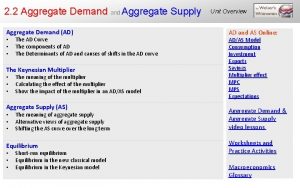AP Macroeconomics Aggregate Demand Aggregate Demand Aggregate Demand
















- Slides: 16

AP Macroeconomics Aggregate Demand

Aggregate Demand • Aggregate Demand is the relationship between all spending on domestic output and the average price level of that output.

Aggregate Demand • Demand in the macroeconomy comes from four general sources, and we have already seen these components when we describe how total production is measured in the economy. • GDPr=C+I+G+(X-M)

Aggregate Demand (AD) = GDPr = C + G + Ig + Xn • Shows the amount of Real GDP that the private, public and foreign sector collectively desire to purchase at each possible price level • The relationship between the price level and the level of Real GDP is inverse – See graph

Aggregate Demand • So AD measures, for any price level, the sum of consumption spending by households, investment spending by firms, government purchases of goods and services, and the next export bought by foreign consumers.

Aggregate Demand Curve PL AD GDPR

Three Reasons AD is downward sloping • Real-Balances Effect – If the price is too high, demand will decrease – When the price is low, demand tends to increase…duh • Interest-Rate Effect – High prices (inflation) increases the value of a $, this leads to high interest rates which leads to lower Ig – low prices (disinflation) decreases the value of a $ thus lower interest rates which tends to encourage Ig • Foreign Purchases Effect – A high $ value means our exports are too high, leading to lower Xn. – A low $ value means our exports are cheap, leading to a higher Xn

Shifts in Aggregate Demand (AD) • There are two parts to a shift in AD: – A change in C, IG, G and/or XN – A multiplier effect that produces a greater change than the original change in the 4 components • • Increases in AD = AD Decreases in AD = AD

Increase in Aggregate Demand PL AD AD 1 GDPR

Decrease in Aggregate Demand PL AD 1 AD GDPR

Determinants of AD • • Consumption (C) Gross Private Investment (IG) Government Spending (G) Net Exports (XN) = Exports - Imports (X – M)

Consumption • Household spending is affected by: – Consumer wealth (income effect) • More wealth = more spending (AD shifts ) • Less wealth = less spending (AD shifts ) – Consumer expectations (good news/bad news) • Positive expectations = more spending (AD shifts ) • Negative expectations = less spending (AD shifts ) – Household indebtedness • Less debt = more spending (AD shifts ) • More debt = less spending (AD shifts ) – Taxes • Less taxes = more spending (AD shifts ) • More taxes = less spending (AD shifts )

Gross Private Investment • Investment Spending is sensitive to: – The Real Interest Rate • Lower Real Interest Rate = More Investment (AD ) • Higher Real Interest Rate = Less Investment (AD ) – Expected Returns • Higher Expected Returns = More Investment (AD ) • Lower Expected Returns = Less Investment (AD ) • Expected Returns are influenced by – – Expectations of future profitability Technology Degree of Excess Capacity (Existing Stock of Capital) Business Taxes • Hyperlink to Investment. Demand. pps

Government Spending • More Government Spending (AD ) • Less Government Spending (AD )

Net Exports • Net Exports are sensitive to: – Exchange Rates (International value of $) • Strong $ = More Imports and Fewer Exports = (AD ) • Weak $ = Fewer Imports and More Exports = (AD ) – Relative Income • Strong Foreign Economies = More Exports = (AD ) • Weak Foreign Economies = Less Exports = (AD )

Summary • AD reflects an inverse relationship between PL and GDPR • Δ in PL creates real-balance, interest-rate, and foreign purchase effects that explain AD’s downward slope • Δ in C, IG, G, and/or XN cause Δ in GDPR because they Δ AD. • Increase in AD = AD • Decrease in AD = AD
 Shift in sras curve
Shift in sras curve Unit 3 aggregate demand aggregate supply and fiscal policy
Unit 3 aggregate demand aggregate supply and fiscal policy Aggregate demand and aggregate supply
Aggregate demand and aggregate supply Aggregate supply shifters
Aggregate supply shifters Unit 3 aggregate demand aggregate supply and fiscal policy
Unit 3 aggregate demand aggregate supply and fiscal policy Nicepp
Nicepp Cannot mix aggregate and non aggregate tableau
Cannot mix aggregate and non aggregate tableau How to calculate nominal gdp with base year
How to calculate nominal gdp with base year Recessionary gap aggregate demand
Recessionary gap aggregate demand The aggregate real money demand schedule l(r,y)
The aggregate real money demand schedule l(r,y) Sras lras
Sras lras Aggregate demand graph
Aggregate demand graph Aggregate of chapter 6
Aggregate of chapter 6 Contractionary monetary policy graph
Contractionary monetary policy graph Real interest rate formula
Real interest rate formula Which of the following shifts aggregate demand to the left?
Which of the following shifts aggregate demand to the left? Aggregate supply shocks
Aggregate supply shocks







